#manhattan schist
Link
Today’s Young Wizards-universe side quest: Finding a wizardly explanation for this.
(NB: Thanks in advance, but I am not asking for suggestions. Any suggestions made will have to be discarded.
So... just stare at the thing, because there it is.
165 notes
·
View notes
Text
Gapstow Bridge
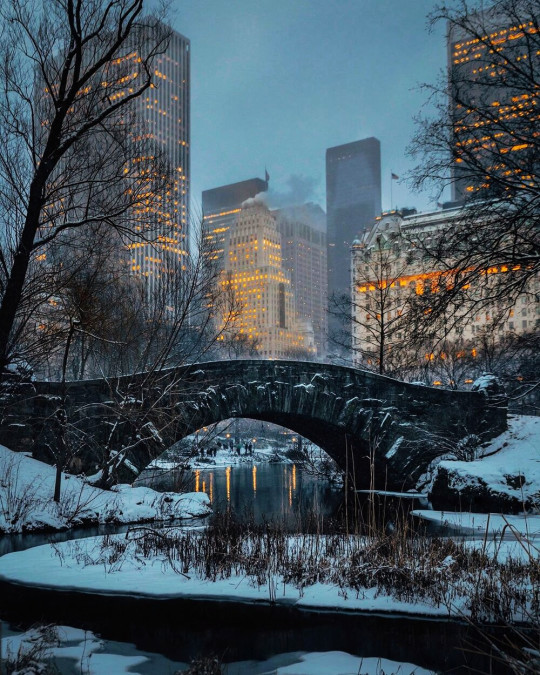
Gapstow Bridge, New York, NY 10019
Gapstow Bridge is one of the charming and iconic bridges located within Central Park in Manhattan, New York City. It is renowned for its picturesque setting and is a favorite spot for park visitors, photographers, and tourists. Here are some key details about Gapstow Bridge:
Location: Gapstow Bridge is situated in the southeast section of Central Park, spanning across the eastern end of the Pond. It is in close proximity to Wollman Rink, the Central Park Zoo, and The Plaza Hotel.
Design and Architecture: The bridge was originally designed by Jacob Wrey Mould in 1874, and it was rebuilt in its current form in 1896. Gapstow Bridge is a graceful and elegant structure, characterized by its curved, semi-circular shape and elegant stone arches. It is constructed primarily of Manhattan schist, a type of local bedrock.
Scenic Views: Gapstow Bridge offers breathtaking views of the surrounding landscape, including the Pond, with its reflections of the city skyline, and the lush greenery of Central Park. The bridge's stone parapets and balustrades provide a perfect frame for capturing memorable photographs.
Seasonal Beauty: Gapstow Bridge takes on a different charm in each season. In the spring, it is surrounded by blooming flowers and vibrant greenery. During the fall, the surrounding trees display a riot of autumn colors, creating a stunning backdrop.
Cultural Significance: The bridge has been featured in various films, television shows, and photography exhibits, contributing to its cultural significance. Its timeless design and tranquil setting make it a popular choice for filmmakers and artists.
Ice Skating: In the winter months, the Pond below Gapstow Bridge often freezes, providing a picturesque setting for ice skating. The nearby Wollman Rink is a popular destination for both locals and tourists seeking winter recreation.
Accessibility: Gapstow Bridge is accessible by pedestrian pathways within Central Park, making it a convenient stop for visitors exploring the park on foot or by bike.
Historical Significance: Like many features in Central Park, Gapstow Bridge is a testament to the park's historical and architectural heritage. It serves as a reminder of the park's original design by Frederick Law Olmsted and Calvert Vaux in the mid-19th century.
Adjacent Landmarks: The bridge's location near the Central Park Zoo and Wollman Rink makes it a central part of the park's recreational and cultural offerings. Visitors often combine their visits to these nearby attractions with a stroll across Gapstow Bridge.
In summary, Gapstow Bridge is a beloved and picturesque landmark within Central Park, known for its graceful design and stunning views. Whether you're seeking a scenic spot for photography, a tranquil place to enjoy nature, or a beautiful backdrop for leisurely walks, Gapstow Bridge offers a serene and timeless experience in the heart of Manhattan.
#Gapstow Bridge#Bridge#Central Park#New York City#new york#newyork#New-York#nyc#NY#manhattan#urban#city#USA#buildings#visit-new-york.tumblr.com
191 notes
·
View notes
Text
The primary result of me doing accuracy research for the upcoming chapter of Something Wicked is that I have learned more about the New York City sewer system and the diversion of Manhattan's rivers to run underground than I ever thought I would, while simultaneously not doing any actual writing.

(As a side note, Manhattan schist has captured my heart.)
20 notes
·
View notes
Note
trick or treat!
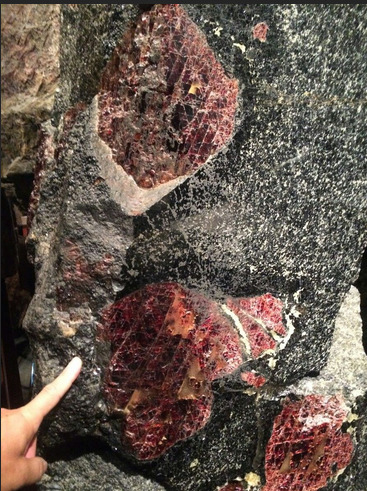
here is manhattan schist <3
2 notes
·
View notes
Text

Giant-Size Man-Thing #2 (Gerber/Buscema, Nov 1974). Schist’s widow funds an expedition to capture her late husband’s killer. The NY Ecological History Museum, with support from Stark Industries, manages to abduct the Man-Thing from the Everglades and transport him to a public exhibit in Manhattan… Surprisingly, Reed Richards and Tony Stark both support the exhibition. It’s all undone by the issue’s end, but I guess now it’s public knowledge that the Man-Thing is real!
#marvel#marvel 616#giant size man thing#ted sallis#man thing#reed richards#mr fantastic#ben grimm#the thing#johnny storm#human torch#tony stark#iron man#steve gerber#john buscema
6 notes
·
View notes
Text
Casago says Roosevelt Island is the most "serene escape" in New York City... But, well...
So, what is Casago, and more importantly, why do they say that Roosevelt Island is the most serene escape in New York City? It’s “a vacation rental property management company servicing homeowners and guests in Mexico and the U.S.”
But how they decided that this long stretch of Manhattan schist, massaged by channels in the East River, is the ultimate NYC place of Zen is a little iffy.
by David…

View On WordPress
0 notes
Photo

Central Park’s Gapstow Bridge in the Spring, it has been featured on the silver screen so many time it’s as synonymous with New York City as the Empire State Building. What many people do not know is it’s not the original bridge in the original Fredrick Law Olmsted and Calvert Vaud design. The original bridge was a wooden one that did not fare well, and this lovely stone bridge made of Manhattan schist takes park visitors over the pond. - [ ] #developportdev @gothamtomato @developphotonewsletter @omsystem.cameras #excellent_america #omsystem @bheventspace @bhphoto @adorama @tamracphoto @tiffencompany @nycurbanism @nybucketlist @centralparknyc #centralpark (at Central Park, Manhattan, New York) https://www.instagram.com/p/Cf-m6YkLlyC/?igshid=NGJjMDIxMWI=
1 note
·
View note
Photo

In Morningside Heights you can find a boulder 30-feet high and 100-feet long sandwiched between two apartment buildings. This giant piece of schist, nicknamed the "Rat Rock", can tell us a lot about New York City's history. https://t.co/27rPC2h0pU
— Gothamist (@Gothamist) Jul 6, 2021
18 notes
·
View notes
Video
vimeo
Don’t miss all the outcrops of Manhattan Schist and views of the glacial scour marks in this video! Original caption:
Filmed over the course of two years, The Seasons of Central Park chronicles the incredible seasonal and atmospheric changes that take place every year throughout Central Park. Home to centuries-old bridges, 20,000 trees and 9,000 park benches, this two and half mile park is a beloved New York icon.
This video was constructed by capturing time-lapses, from the same location with identical framing, throughout the year. Each single composition shows a portion of each season composited within the frame.
Created by Tyler Fairbank
Licensing, project inquiries or questions: [email protected]
tylerfairbank.com
Music:
Waltz of the Flowers (from the Nutcracker) - Tchaikovsky
*public domain, royalty-free
The video is composed of raw still image sequences captured in 8.6K resolution. For editing the sequences, I used LRTimelapse, Lightroom, After Effects, and Photoshop.
#new york#city#timelapse#weather#spring#summer#tourist#travel#people#music#video game#vimeo#day#clouds#geology#schist#fall#autumn#manhattan schist#snow#video#nature#central park#the earth story
73 notes
·
View notes
Photo



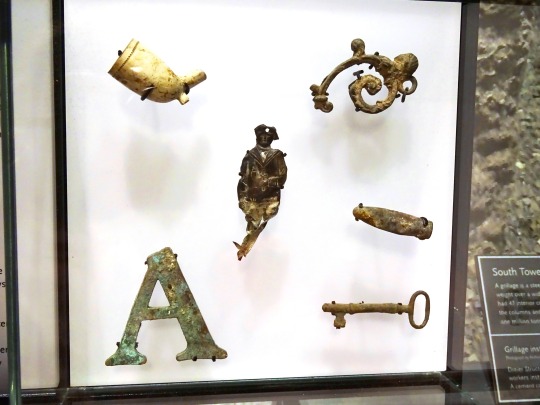
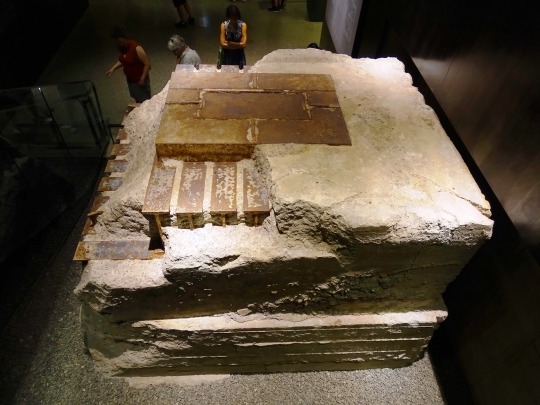

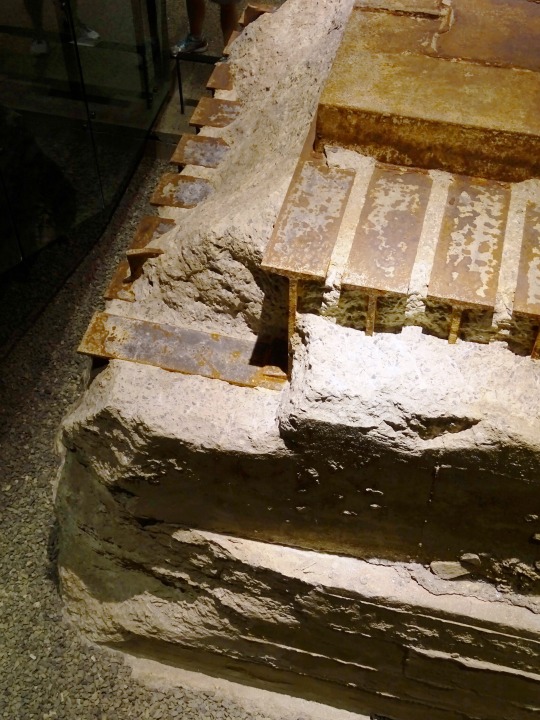


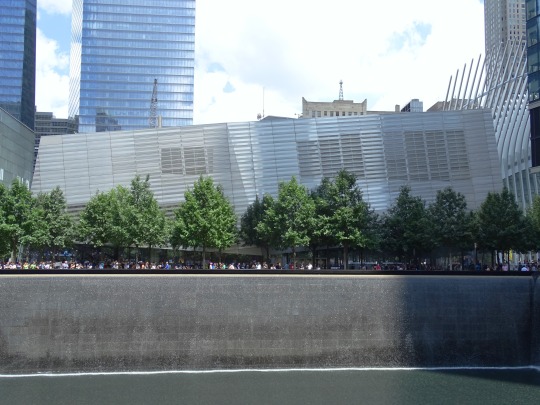
National September 11 Memorial & Museum, Manhattan (No. 9)
Recovered clay pipe head with small decorative detailing. Scratched and damaged.
Recovered metal skeleton key coated in dirt and concrete residue.
Recovered metal figure of a sailor. The legs of the figure are bent and concrete and dirt have collected in the crevices.
Recovered metal shell casing, damaged and coated in dirt.
Recovered metal fragment in a filigree design coated in dirt and concrete residue.
Much of lower Manhattan is built atop landfill, evidence of the city’s growth and changing demographics. Buttons, keys, pottery shards, and other artifacts predating the American Revolutionary War (1775–1783) were unearthed in 2006 by forensic archaeologists searching near the World Trade Center site for remains of 9/11 victims. During a subsequent dig in 2010, they found the remains of an 18th-century ship. When the archaeologists uncovered these premodern artifacts, they knew they had reached the Colonial strata of the site.
Source
#National September 11 Memorial & Museum#Michael Arad#Peter Walker#USA#Davis Brody Bond#Reflecting Absence#exterior#interior#Manhattan schist#bedrock#Let Freedom Ring by Kathryn Mellusi#World Trade Center#travel#The Shield by Red Grooms#Sirius by Ron Burns#K9#dog#archaeological remnants#Lower Manhattan#New York City#summer 2018#original photography#9/11#11 September 2001
0 notes
Photo

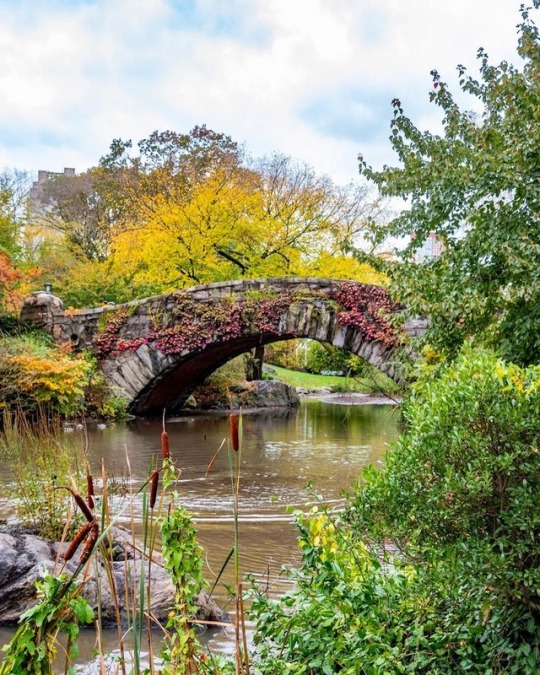
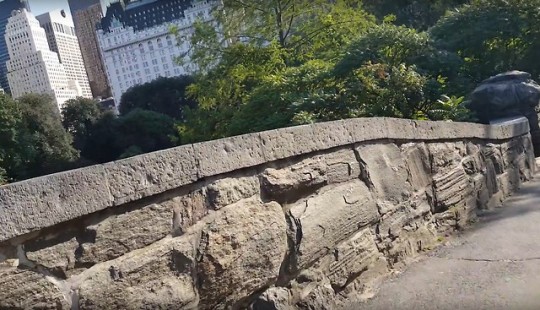
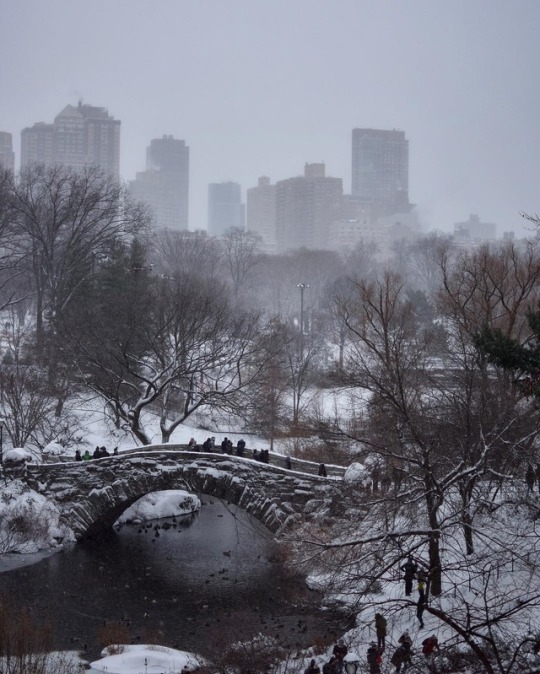
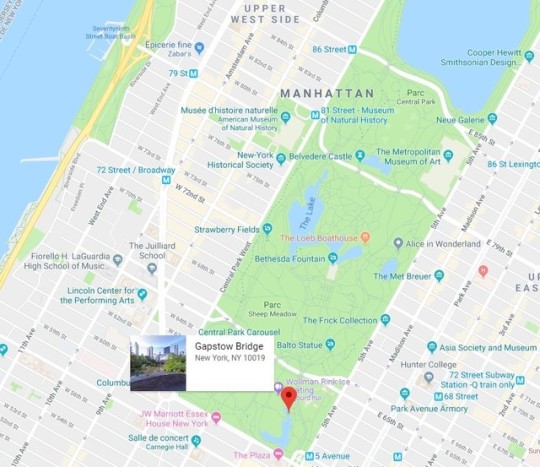
Bearing a striking resemblance to the Ponte di San Francesco in San Remo, Italy, Gapstow Bridge is yet another example of traditional architecture in Central Park.
Gapstow Bridge is one of the icons of Central Park, Manhattan in New York City. The first bridge was designed by Jacob Wrey Mould in 1874. The bridge was a wooden bridge with intricate cast iron railings. Due to excessive tear and wear, it was replaced by the present simple stone structure in 1896, by Howard & Caudwell. The schist stone span curves over the narrow neck of The Pond. Facing south, it offers a view of the city, the Plaza Hotel and other buildings. Gapstow stands 12 feet high, spans 44 feet of water, and stretches 76 feet in its full length. During the warm weather green foliage will cover the bridge.
It is most accessible by entering the Park at the corner of Central Park South and Fifth Avenue and following the path that runs to the right counter-clockwise along the perimeter of the Pond.
└─► The Complete Guide to New York’s Central Park
└─► Gapstow Bridge in Central Park
#manhattan#midto#central park#centralpark#central park south#gapstow bridge#jacob wrey mould#iconic bridge#plaza hotel#howard & caudwell#the pond#fifth avenue#59th street#ponte di san francesco#olmsted and vaux#central park iconic bridge#schist bridge#wollman rink#midtown manhattan#ponte di francesco#sanremo
456 notes
·
View notes
Text
Thalia & Zeus Father/Daughter Headcanons (the drama is real, ya’ll.) :
They fight C O N S T A N T L Y. But, even though he’s an absolute dirtbag and a sorry excuse for a father, he can never bring himself to actually use those godly-powers of his to punish her. He grounds her all the time, which she hates but doesn’t really dare disobey, but she doesn’t fear him, and that’s new to him. He wants her trust, so he controls himself when he gets mad, even if it takes every ounce of energy he has not to blast her into next Tuesday.
She never forgives him for letting Jason die, and he never asks for it.
They have a... rocky relationship (at most) but they do care for each other. As much as she is still salty about the whole “being turned into a pine tree for half a decade” thing, she’s (begrudgingly) grateful that he saved her life. And even dirtbag gods love their kids somewhat; he would never want anything to happen to her, even if she gets on his nerves.
It’s an unspoken agreement that they never ever ever bring up Beryl Grace.
It’s just like Zeus to not give one single Hoover Dam about a mortal, and being his daughter’s mother doesn’t change that, apparently. He never feels the need to talk about her. And Thalia is just... being Thalia about it. I mean, her past with her mother was never the best, but then Hera got involved and everything just went downhill. She’s forgiven her mother for her actions but she will not allow anyone to talk about her.
She and Jason had one discussion about her his first week at CHB and they never talked about her again.
This is really mean and very “step-mother/step-daughter probs that they drag the father into” but Thalia and Zeus sometimes bond over how annoying Hera is lol 😂
Thalia and Zeus have only ever hugged once (After the Battle of Manhattan), and she would never admit this, but she cherishes that hug. No matter how irritating or how bad your relationship, I think every kid wants to make their parents proud.
Thalia will humble him, though. She is not afraid to call the Lord of The Sky out on his Minotaur schist.
27 notes
·
View notes
Note
🦀🔑✈️ for the ask game :)
🦀 - hm... if i could control the evolutionary progression of my genetic line i'd DEF give my descendants hollow bird bones
🔑 - limestone for sure but one musn't discount the architectural advantages of manhattan schist
✈️ - 17 OR 352. or 1 million zeroes
7 notes
·
View notes
Text
“These bitches WISH they had Manhattan schist to build on!!! THEY WISH!!!”
#rambling#I took one rock class that I failed because my grandma died#and this is the ONE thing I really retained#this is about a skyscraper is San Fran
2 notes
·
View notes
Text
Episode 1: Parks as Public Health Infrastructure
Portland’s parks are one of my favorite things about the city. When I first moved here, I would take myself of drives just to go check out new parks; I’d walk around by myself and make mental notes, excited to share these spaces with other people in the future.
During the Covid-19 Pandemic, those parks have become even more valuable. I remember in April, my first trip out of the house post-lockdown was to go for a walk at Pier Park in St. Johns. I remember in July, I hung out with some friends in Laurelhurst park, decompressing and enjoying the 9 PM sunset. I remember in August, hanging out with my mom and my sister in the Peninsula Park Rose Garden. These parks have always been there, but I think the pandemic has helped a lot of people appreciate their parks in new ways.

Portland’s Mt. Tabor Park.
Portland owes many of its great parks to the Olmstead Brother’s plan. In the early 1900’s, the city commissioned the Olmstead Brothers, sons of famed landscape architect and designer of New York City’s Central Park, Frederick Law Olmstead, to design a system of parks for the growing city. Peninsula Park, Sellwood Park, Laurelhurst Park, Mount Tabor Park and Forest Park were all sited and designed in reference to the Olmstead plan.
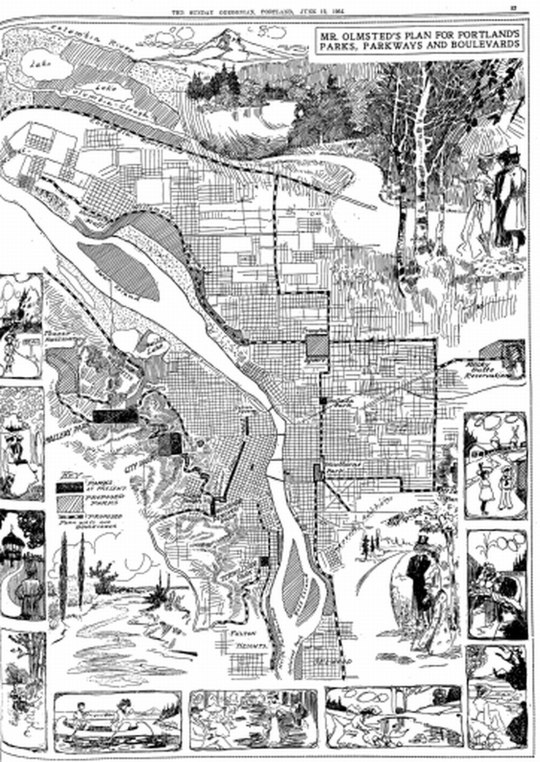
An Illustration from the Olmstead Plan, which can be found in the book “Legacy of the Olmsted Brothers in Portland” by William Hawkins.
When Olmstead designed Central Park for a growing city on Manhattan island, he did so understanding that parks were a critical piece of public health infrastructure. Looking at a map of Manhattan today, it seems inconceivable that 1.3 square miles of developable land would be set aside as a park, but Olmstead’s plan found support from a New York City that was recovering from deadly Cholera epidemics in 1832 and 1849 that killed over 8,500 people- bringing the issue even closer to home, Olmstead’s first child died of Cholera in 1860.
The precursor to the germ theory of disease transmission was the “miasma” theory; people believed that disease was caused by odors and vapors from decomposing garbage and sewage. It was also widely accepted that plants and sunlight were capable of sanitizing “miasmic” or “vitious” air. Olmstead’s Central Park was designed to help prevent future epidemics by purifying the city’s air and offering city-dwellers the opportunity to restore their health.
Olmstead wrote: “Opportunity and inducement to escape at frequent intervals from the confined and vitiated air of the commercial quarter, and to supply the lungs with air screened and purified by trees and recently acted on by sunlight, together with opportunity and inducement to escape from situations requiring vigilance, wariness, and activity towards other men- if these could be supplied economically, our problem would be solved.” The emergency and gravity of the cholera epidemics gave Olmstead and city politicians the political license to carry forward big ideas like Central Park, providing a public benefit and taking steps to prevent the next pandemic (although modern science tells us that plants don’t exactly sanitize the air the way they believed).
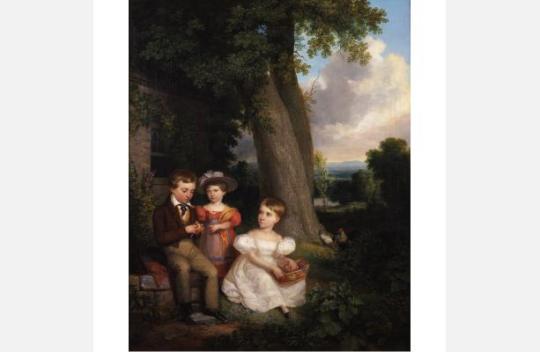
Hudson River School painter Asher Durand painted this portrait of his children in an upstate NY Apple Orchard in 1832; continuing the long-standing tradition of wealthy people escaping to their idyllic countryside homes when pandemics strike in urban areas. Given the year of this painting it’s not hard to connect it to the 1832 Cholera epidemic in New York- bet you didn’t think I was going to sneak art history into this one.

It’s worth remembering that Central Park is a completely manufactured landscape. Marshes were drained and streams were created completely artificially. From the Central Park Conservancy, “its only natural feature is the metamorphic rock, called Manhattan schist, that’s approximately 450 million years old.” The rest is a work of art- deliberately crafted from the natural medium.
The tie between Central Park and public health goes deeper considering that the Jacqueline Kennedy Onassis Reservoir, across from the Guggenheim Museum, actually predates the rest of Central Park,* and was the first major attempt made to bring clean water to the growing city. Even before germ theory, public health officials could tell that there was some connection between water and cholera, and set about building an aqueduct to deliver water from the Croton Reservoir 22 miles to the north.
In an age when most New Yorkers didn’t have access to running water, the clean water that could be found in the park was another draw. An 1870 guidebook to the park encouraged visitors to ‘drink their fill’ from the ‘inexhaustible cisterns.’ Ornate drinking fountains were placed around the park, including one near The Mall that used underground blocks of ice to cool the water.
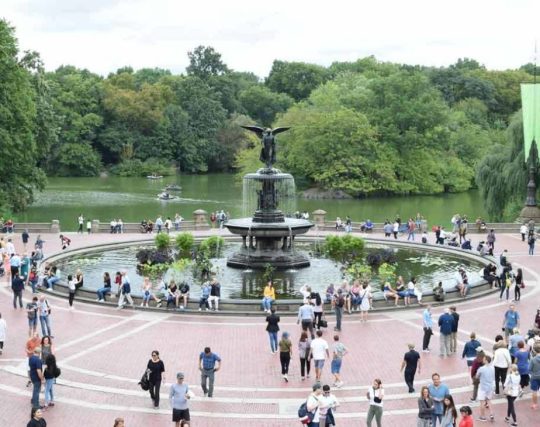
The Bethesda Fountain, just south of The Lake, was built as a monument to the completion of the Croton Aqueduct. This statue was the first major art commission in New York City granted to a woman. Stebbins was also a lesbian and used her partner Charlotte Cushman as a model for the statue; although in 1840′s language they were just two female best friends who lived together for many years and for some reason never married men.
The huge supply of fresh, clean water suddenly available in Central Park allowed New York city planners to begin delivering running water to homes in Greenwich Village, Gramercy Park, and Chelsea, neighborhoods that were initially upper-class suburbs created for people trying to escape the overcrowded tenements in the areas around the Five Points. An 1822 yellow fever epidemic provided the first major wave of resettlement from lower Manhattan to Greenwich Village, the second was spurred by a building boom that occurred as another wave of people tried to escape the tenements for safer living conditions during the 1832 cholera epidemic. The city spread farther north to Gramercy Park in 1842 when the reservoir was complete.
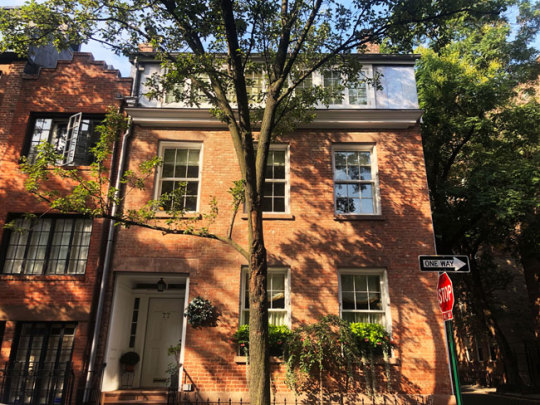
This house at 77 Beford Street is considered to be the oldest original home in Greenwich Village, depending on how you define the boundaries of the village, and depending on if you count the fact that it was significantly upgraded in 1832 as a mark against its authenticity. Rabbit hole, here.
As New Yorkers with the means to do so moved further north and closer to Central Park, the Park seems to have had a sort of “greening” influence on the rest of the city, spreading clean air and water southwards into the working class and immigrant communities in the city. In the 1860’s and 70’s, the city of New York took its first steps towards operating as a housing authority, passing laws requiring that tenements begin offering indoor, running water and at least one window to the outdoors in each unit (creating the dog-bone or dumbbell shape we know today). In an effort to bring running water and centralized sewage service further south into Manhattan, the city began tearing up the streets and installing sewer pipes. When the streets were repaved, they used materials like concrete and asphalt to allow for weekly street washing and sweeping services. City planners began including space for alleyways in their designs, so that trash didn’t have to be placed directly on the street.*
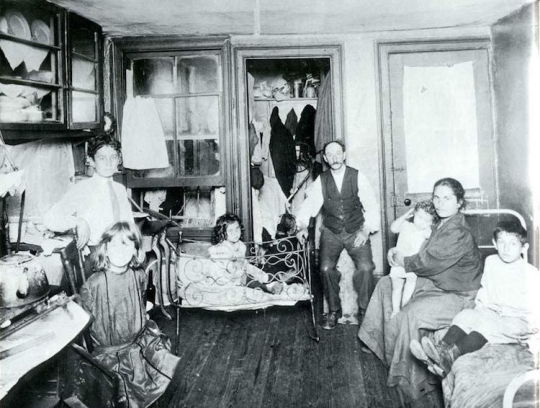
This photo by Jacob Riis from “How The Other Half Lives” was an expose on tenement living conditions. Homes were often extremely poorly ventilated, often without any kind of exterior doors or windows. Sinks were shared among many residents, and bathrooms were outdoor outhouses.
This article from the Central Park Conservancy argues that we should think of Central Park itself as a critical piece of public health infrastructure. Olmstead’s park provided clean air and water to New York residents at a time when many didn’t have running water, a window to the outside, or a way to escape the garbage and sewage in the streets. But as time went on, the Park not only provided a place to escape to, but a place that established an ideal: that clean water and air should be brought to all parts of the city for all citizens to enjoy, not just within the 1.3 square miles of park boundary- and over time, the city housing authority made steps toward that ideal.
“All these influences have a strangely powerful force,” writes an 1870’s guidebook to Central Park, about the power of a visit to the Park. “They compel the soul. It is almost impossible to do any thing in the park but rest, breath sweet air, and enjoy.”
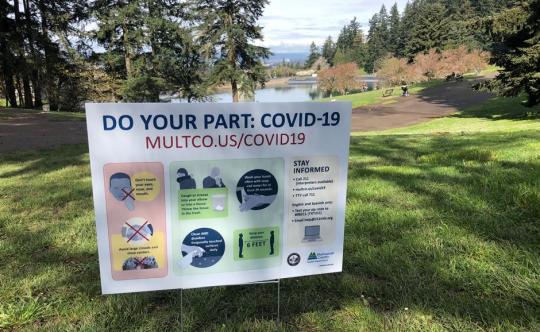
“Do your Part” Coronavirus warning sign at Mt. Tabor over the summer.
I’m interested to see the ways in which Portland residents are enjoying those same benefits today, in light of a global pandemic. I’m also interested to see the other ways this cycle repeats. Will we see a post-pandemic return to the suburbs as people retreat from densely-populated and “unclean” urban areas? What kinds of infrastructural changes will be made to our built environment as city planners and urban designers imagine the next public health crisis?
Liner Notes:
*RE: reservoir- kind of. There was an older, rectangular reservoir built in 1842 that was later replaced in 1860 with a more organic shaped reservoir designed to better fit in with the nature-inspired elements of central park, and that reservoir has also been replaced by the one there today. I could have been more careful about this in writing but I think it’s safe to say that a reservoir (of some shape) occupied that spot (in general) in the park since 1842.
*RE Alleyways- Yes, they began making space for alleyways, but large sections of Manhattan were built before this need for alleys was realized, and they couldn’t exactly go back and put them there, so there are virtually no alleyways in Manhattan; most are in other boroughs.
I acknowledge that New York City has a rocky history with parks; see Jane Jacob’s description of parks as places that provide cover for youth to bully other youth; see Robert Moses’ time in New York City and the overt racism he displayed when choosing the locations of parks and sites for playground equipment. Even within the 1840s, there would have been race and class dynamics at play, too- not everyone would have had equitable access to a public health resource like Central Park. This warrants its own investigation and I felt like I didn’t have the sources nor the scope to include that here. If anyone has any sources that talk about access to parks in the 19th and early 20th century, I’d like to know!
4 notes
·
View notes
Text
Thor SMath!
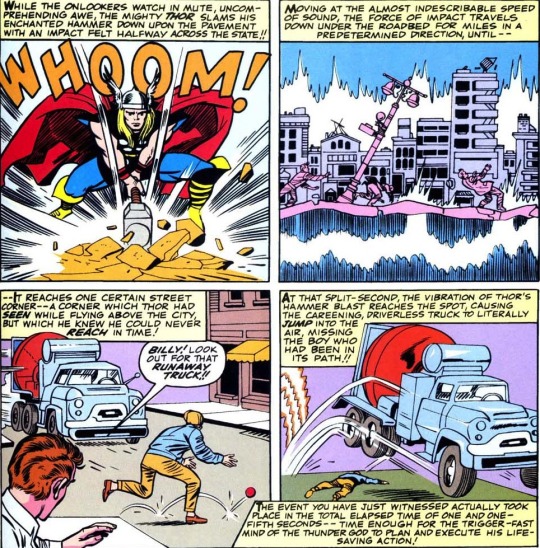
I was out of town for a speculative fiction convention participating on a couple of panels (Yes, one was on the MCU. Great times had by all.), so this week’s post is super duper (duper) fast.
Just math.
One moment of math I needed to fact-check:
“Moving at the almost indescribable speed of sound...for miles” that also only happened in 1.2 seconds.
The speed of sound depends on how dense the material the sound wave is traveling through. In air, that density depends on how far up into the atmosphere you are and what the temperature is. At sea level and 20 °C (68 °F), it’s about 343 m/s (767 mph). In 1.2 seconds a sound wave going through air would travel a whopping 411.6 meters (just over a quarter mile).
That’s much shorter than what the comic claims, but we must remember that this sound wave isn’t traveling through the air. It’s underground.
In general, sound travels faster through liquids than it does gases, and solids faster than it does liquids.
But that’s not a universally applicable rule.
I don’t know the exact mineral composition of New York’s dirtbed, but this paper cites speeds in different soils as between 86 and 260 m/s. It’s lower than air because it’s not an actual solid solid. There are air pockets (and water, too) which actually causes the speed of sound through soil to drop below that of air itself.
So the speed of sound through dirt is slower than that through air at sea level, meaning it’s even further away from the quote of “miles”.
What about rock? That’s more solid.
Manhattan’s bedrock is a variety of mica schist. Mica schist has a sound speed of 5501 m/s and 3124 m/s for P-waves and S-waves, respectively. People who live in earthquake-prone areas might be familiar with those terms already, but for those of you that aren’t in the know, those are the two waves that travel through the earth during a quake (as opposed to surface waves). P-waves are compression waves, just like sound waves are.
So using the 5501 m/s, Thor’s destruction wave would travel ~6.6 km in 1.2 seconds, or 4.1 miles.
Yup. Miles.
So as long as it’s rock instead of dirt immediately underneath that road, we’re good.
Math over.
Journey Into Mystery #108 - Writer: Stan Lee, Art: Jack Kirby, Ink: Chic Stone
1 note
·
View note